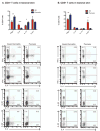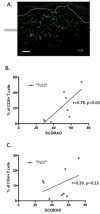IL-22-producing "T22" T cells account for upregulated IL-22 in atopic dermatitis despite reduced IL-17-producing TH17 T cells
- PMID: 19439349
- PMCID: PMC2874584
- DOI: 10.1016/j.jaci.2009.03.041
IL-22-producing "T22" T cells account for upregulated IL-22 in atopic dermatitis despite reduced IL-17-producing TH17 T cells
Abstract
Background: Psoriasis and atopic dermatitis (AD) are common inflammatory skin diseases. An upregulated TH17/IL-23 pathway was demonstrated in psoriasis. Although potential involvement of TH17 T cells in AD was suggested during acute disease, the role of these cells in chronic AD remains unclear.
Objective: To examine differences in IL-23/TH17 signal between these diseases and establish relative frequencies of T-cell subsets in AD.
Methods: Skin biopsies and peripheral blood were collected from patients with chronic AD (n = 12) and psoriasis (n = 13). Relative frequencies of CD4+ and CD8+ T-cell subsets within these 2 compartments were examined by intracellular cytokine staining and flow cytometry.
Results: In peripheral blood, no significant difference was found in percentages of different T-cell subsets between these diseases. In contrast, psoriatic skin had significantly increased frequencies of TH1 and TH17 T cells compared with AD, whereas TH2 T cells were significantly elevated in AD. Distinct IL-22-producing CD4+ and CD8+ T-cell populations were significantly increased in AD skin compared with psoriasis. IL-22+CD8+ T-cell frequency correlated with AD disease severity.
Conclusion: Our data established that T cells could independently express IL-22 even with low expression levels of IL-17. This argues for a functional specialization of T cells such that "T17" and "T22" T-cells may drive different features of epidermal pathology in inflammatory skin diseases, including induction of antimicrobial peptides for "T17" T cells and epidermal hyperplasia for "T22" T-cells. Given the clinical correlation with disease severity, further characterization of "T22" T cells is warranted, and may have future therapeutic implications.
Figures






References
-
- Li J, Chen X, Liu Z, Yue Q, Liu H. Expression of Th17 cytokines in skin lesions of patients with psoriasis. J Huazhong Univ Sci Technolog Med Sci. 2007;27:330–2. - PubMed
-
- Lowes MA, Kikuchi T, Fuentes-Duculan J, Cardinale I, Zaba LC, Haider AS, et al. Psoriasis vulgaris lesions contain discrete populations of Th1 and Th17 T cells. J Invest Dermatol. 2008;128:1207–11. - PubMed
-
- Zheng Y, Danilenko DM, Valdez P, Kasman I, Eastham-Anderson J, Wu J, et al. Interleukin-22, a T(H)17 cytokine, mediates IL-23-induced dermal inflammation and acanthosis. Nature. 2007;445:648–51. - PubMed
Publication types
MeSH terms
Substances
Grants and funding
LinkOut - more resources
Full Text Sources
Other Literature Sources
Medical
Research Materials

